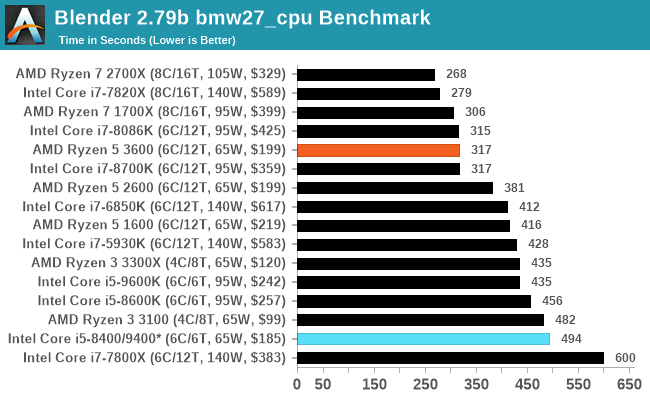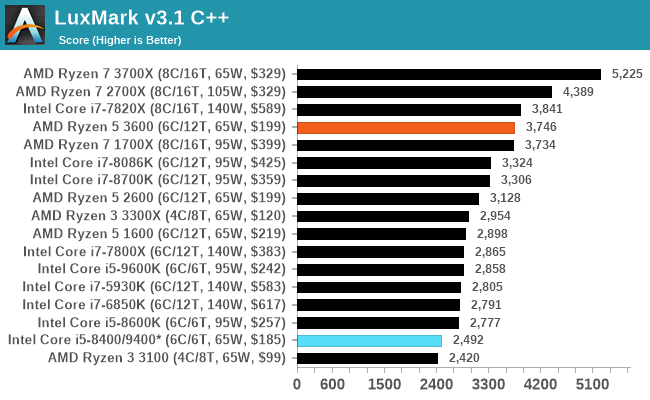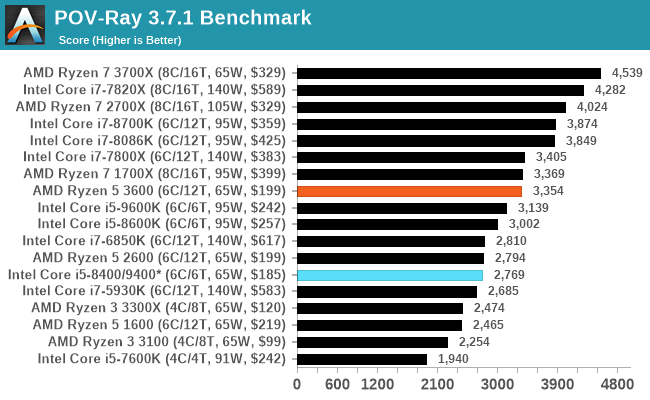AMD Ryzen 5 3600 Review: Why Is This Amazon's Best Selling CPU?
by Dr. Ian Cutress on May 18, 2020 9:00 AM ESTCPU Performance: Rendering Tests
Rendering is often a key target for processor workloads, lending itself to a professional environment. It comes in different formats as well, from 3D rendering through rasterization, such as games, or by ray tracing, and invokes the ability of the software to manage meshes, textures, collisions, aliasing, physics (in animations), and discarding unnecessary work. Most renderers offer CPU code paths, while a few use GPUs and select environments use FPGAs or dedicated ASICs. For big studios however, CPUs are still the hardware of choice.
All of our benchmark results can also be found in our benchmark engine, Bench.
Corona 1.3: Performance Render
An advanced performance based renderer for software such as 3ds Max and Cinema 4D, the Corona benchmark renders a generated scene as a standard under its 1.3 software version. Normally the GUI implementation of the benchmark shows the scene being built, and allows the user to upload the result as a ‘time to complete’.
We got in contact with the developer who gave us a command line version of the benchmark that does a direct output of results. Rather than reporting time, we report the average number of rays per second across six runs, as the performance scaling of a result per unit time is typically visually easier to understand.
The Corona benchmark website can be found at https://corona-renderer.com/benchmark

Blender 2.79b: 3D Creation Suite
A high profile rendering tool, Blender is open-source allowing for massive amounts of configurability, and is used by a number of high-profile animation studios worldwide. The organization recently released a Blender benchmark package, a couple of weeks after we had narrowed our Blender test for our new suite, however their test can take over an hour. For our results, we run one of the sub-tests in that suite through the command line - a standard ‘bmw27’ scene in CPU only mode, and measure the time to complete the render.
Blender can be downloaded at https://www.blender.org/download/

LuxMark v3.1: LuxRender via Different Code Paths
As stated at the top, there are many different ways to process rendering data: CPU, GPU, Accelerator, and others. On top of that, there are many frameworks and APIs in which to program, depending on how the software will be used. LuxMark, a benchmark developed using the LuxRender engine, offers several different scenes and APIs.
In our test, we run the simple ‘Ball’ scene on both the C++ and OpenCL code paths, but in CPU mode. This scene starts with a rough render and slowly improves the quality over two minutes, giving a final result in what is essentially an average ‘kilorays per second’.

POV-Ray 3.7.1: Ray Tracing
The Persistence of Vision ray tracing engine is another well-known benchmarking tool, which was in a state of relative hibernation until AMD released its Zen processors, to which suddenly both Intel and AMD were submitting code to the main branch of the open source project. For our test, we use the built-in benchmark for all-cores, called from the command line.
POV-Ray can be downloaded from http://www.povray.org/












114 Comments
View All Comments
PeachNCream - Monday, May 18, 2020 - link
Anandtech spends a lot of time on gaming and on desktop PCs that are not representative of where and how people now accomplish compute tasks. They do spend a little time on mobile phones and that nets part of the market, but only at the pricey end of cellular handsets. Lower cost mobile for the masses and work-a-day PCs and laptops generally get a cursory acknowledgement once in a great while which is disappointing because there is a big chunk of the market that gets disregarded. IIRC, AT didn't even get around to reviewing the lower tiers of discrete GPUs in the past, effectively ignoring that chunk of the market until long after release and only if said lower end hardware happened to be in a system they ended up getting. They do not seem to actively seek out such components, sadly enough.whatthe123 - Monday, May 18, 2020 - link
AI/tensorflow runs so much faster even on mid tier GPUs that trying to argue CPUs are relevant is completely out of touch. No academic in their right mind is looking for a bang-for-buck CPU to train models, it would be an absurd waste of time.wolfesteinabhi - Tuesday, May 19, 2020 - link
well ..games also run on GPU ...so why bother benchmarking CPU's with them? ... same reason why anyone would want to look at other workflows .. i said tensor flow as just one of the examples(maybe not the best example) ..but more of such "work" or "development" oriented benchmarks.pashhtk27 - Thursday, May 21, 2020 - link
Or there should be proper support libraries for the integrated graphics to run tensor calculations. That would make GPU-less AI development machines a lot more cost effective. AMD and Intel are both working on this but it'll be hard to get around Nvidia's monopoly of AI computing. Free cloud compute services like colab have several problems and others are very cost prohibitive for students. And sometimes you just need to have a local system capable of loading and predicting. As a student, I think it would significantly lower the entry threshold if their cost effective laptops could run simple models and get output.We can talk about AI benchmarks then.
Gigaplex - Monday, May 18, 2020 - link
As a developer I just use whatever my company gives me. I wouldn't be shopping for consumer CPUs for work purposes.wolfesteinabhi - Tuesday, May 19, 2020 - link
not all developers are paid by their companies or make money with what they develop ... some are hobbyists and some do it as their "side" activities and with their own money at home apart from what they do at work with big guns!.mikato - Sunday, May 24, 2020 - link
As a developer, I built my own new computer at work and got to pick everything within budget.Achaios - Monday, May 18, 2020 - link
"Every so often there comes a processor that captures the market. "This used to be Sandy Bridge I5-2500K, all time best seller.
Oh, how the Mighty Chipzilla has fallen.
mikelward - Monday, May 18, 2020 - link
My current PC is a 2500K. My next one will be a 3600.Spunjji - Tuesday, May 19, 2020 - link
Sandy was an absolute knockout. Most of the development thereafter was aimed at sticking similarly powerful CPUs in sleeker packages rather than increasing desktop performance, and while I feel like Intel deserve more credit for some things than they get (e.g. the leap in mobile power/performance that can from Haswell) they really shit the bed on 10nm and responding to Ryzen.